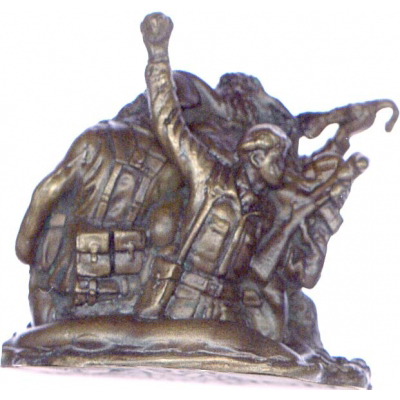Tim Cunliffe is a sculptor and glass artist, whose work focusses on animal imagery. Born in 1960 in Crosby, Merseyside, he studied sculpture at Canterbury College of Art in 1980-83, and did a post-graduate course in stained glass at Central St Martins School of Art in 1988-90, where he was awarded the stained glass fellowship in 1990. He has produced several commissions in stained glass, including a commemorative plaque for Nortel Networks. In 1993 he exhibited at the Stained Glass Museum at Ely cathedral and in the Barbican Centre. His sculptural work in glass was included in the Contemporary glass show at the Geffrye Museum in London during the summer of 2000, and his glass work and modelled reliefs were shown in a group exhibition at the Royal Society of British Sculptors in the same year. His work strives to celebrate animal form through a bold expressive language that echoes ancient and medieval art and often contains elements that tend towards the abstract. About his BAMS medal, the artist writes: ‘The word squama is a zoological term meaning scale or scale-like, referring to such plates on the skin of fishes and reptiles. Squamata is the order of reptiles that includes lizards and snakes. Although the lizard depicted on the medal is based on a British species, I see it more as an archetypal image. ‘The high relief of the reptile’s head on the obverse of the medal evokes a rock projection upon which lizards are often seen basking. As cold-blooded animals, lizards are reliant upon the sun’s heat and usually inactive during the hours of darkness. The geometric pattern of the head plates suggests both the celestial map of a desert night and the cracked surface of sun-baked earth. The centrifugal position of the eye could also read as the concentrated focus of the sun’s rays in the mid-day sky. A playful invitation to explore the reverse of the medal is provided by the tongue of the lizard as it turns a corner on the edge. The reverse depicts the hind quarters and tail of the lizard in low relief. The tail wraps around the lower rim of the medal, with the segmentation of the scales producing a tactile serrated edge. ‘Sympathy towards reptiles and awareness of their future appears far less enthusiastic than that shown towards other ecologically vulnerable species. This attitude is partly a result of bad press and partly the lowly position given to reptiles in the hierarchy of the non-human. This medal humbly sets out to redress the balance.’





